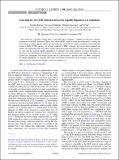Searching for the QCD critical point via the rapidity dependence of cumulants
Author(s)
Mukherjee, Swagato; Brewer, Jasmine Therese; Rajagopal, Krishna; Yin, Yi
DownloadPhysRevC.98.061901.pdf (1.323Mb)
PUBLISHER_CC
Publisher with Creative Commons License
Creative Commons Attribution
Terms of use
Metadata
Show full item recordAbstract
The search for a possible critical point in the QCD phase diagram is ongoing in heavy-ion collision experiments at the BNL Relativistic Heavy Ion Collider (RHIC) which scan the phase diagram by scanning the beam energy; a coming upgrade will increase the luminosity and extend the rapidity acceptance of the solenoidal tracker at RHIC (STAR) detector. In fireballs produced in RHIC collisions, the baryon density depends on rapidity. By employing Ising universality together with a phenomenologically motivated freeze-out prescription, we show that the resulting rapidity dependence of cumulant observables sensitive to critical fluctuations is distinctive. The dependence of the kurtosis (of the event-by-event distribution of the number of protons) on rapidity near midrapidity will change qualitatively if a critical point is passed in the scan. Hence, measuring the rapidity dependence of cumulant observables can enhance the prospect of discovering a critical point, in particular if it lies between two energies in the beam energy scan.
Date issued
2018-12Department
Massachusetts Institute of Technology. Center for Theoretical PhysicsJournal
Physical Review C
Publisher
American Physical Society
Citation
Brewer, Jasmine et al. "Searching for the QCD critical point via the rapidity dependence of cumulants." Physical Review C 98, 6 (December 2018): 061901(R)
Version: Final published version
ISSN
2469-9985
2469-9993